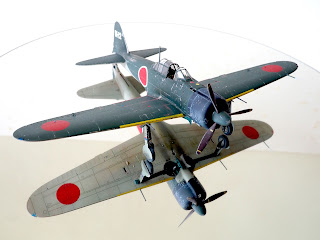A Zero A6M2 Model 21 'II-131' of the 22nd Air Flotilla HQ attached Fighter Group, Malaya 1942, made from the 2009 1/48 Hasegawa kit # 09875 (Mitsubishi A6M2b Zero Fighter Type 21 '3rd Flying Group') with decals from the Rising Decals set RD48021, with Eduard photo-etch details FE358 and Eduard Mask EX040.
A Zero A6M2 Model 21 'B1-12' of 381 Ku at Tebrau, Singapore made from the 2022 1/48 Eduard kit # 82212 (Mitsubishi A6M2 Zero Type 21) with decals from the Berna Decals set BD4858, Eduard Brassin cannon barrels and cowling guns # 648723 and Aber armament and pitot tube set A48106 (Armament for Japanese fighter Mitsubishi A6M5 Zero). This aircraft was later flown and photographed by the Allied Technical Air Intelligence Unit South-East Asia (ATAIU-SEA). At one time the 'B1' tail codes were believed to be ATAIU-SEA designations but in fact they were the original codes for 381 Ku fighters. The unit also operated a few A6M2-K trainers with 'B2' tail codes, at least one A6M3 Model 22, code unknown, another Zero coded 'B1-21' and two Raiden with 'B1-01' and 'B1-02' tail codes applied on overpainted strips concealing a previous code. Both Raiden were test flown by Japanese pilots under ATAIU-SEA supervision.
A Zero A6M5 Model 52 'B1-05' of 381 Ku at Tebrau, Singapore made from the 2008 1/48 Tamiya kit # 61103 (Mitsubishi A6M5/5a Zero Fighter Zeke) with Eduard Mask (EX258) Eduard (491016) photoetch details Aviaeology Japanese tail codes (AOD48C23m) Dead Design Models Japanese National Insignia (VM48094) Aber armament and pitot tube (A48106), Quickboost exhaust (QB48230) and Kits-World seat belts. Another A6M5 of this unit was coded 'B1-26' and an A6M5 Hei coded 'B1-28'. The cockpit and centre section of 'B1-05' are now displayed in the Imperial War Museum, London, with the engine and cowling at the RAF Cosford museum, whilst sadly in 1956 the wings and tail were spotted in the Warrington scrap yard of the British Aluminium Co. Ltd from the top deck of a bus. Large numbers of other Japanese aircraft, including JAAF aircraft, totalling about 60, were burnt, bulldozed and/or scrapped at Tebrau on the orders of the then supreme allied commander South-East Asia Admiral Mountbatten who cancelled a British Ministry of Aircraft Production (MAP) and Air Intelligence plan under the auspices of the RAF to send one example of every Japanese aircraft to the UK for testing and posterity on the grounds that shipping should be prioritised for returning POWs and de-mobbed Allied personnel. The rare Ki-100 fortunately survived because it was mistakenly identified as an 'Oscar', the main fighter type encountered by the RAF over Burma, together with the surviving Ki-46-III, both of which were shipped. together with a 381 Ku Kyushu K9W1 'Cypress' coded 'B2-20' which was later damaged by a fire in storage at RAF Wroughton in the 1950s and subsequently scrapped. An Ohka found at Singapore had also previously been shipped to the UK but alas the Ki-44 made airworthy and flown by the RAF CO at Singapore's Kallang airfield was ultimately scrapped.
With special thanks to Tse Hsien for sharing these images and details of a fine Zero quartet.
Image credit: All photos © 2023 Koh Tse Hsien




































.JPG)
.jpg)
.JPG)
.JPG)
.JPG)
.JPG)
.JPG)
.JPG)
.JPG)
.JPG)
.JPG)
.JPG)
.JPG)
.JPG)
.JPG)
.JPG)
.JPG)
.JPG)